
|
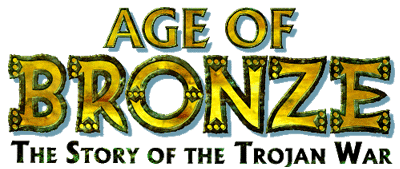
Behold! The Walls of Windy Ilios
A Cartoonist's Adventures in Troy
By Eric Shanower
PART THREE
Back to Part Two
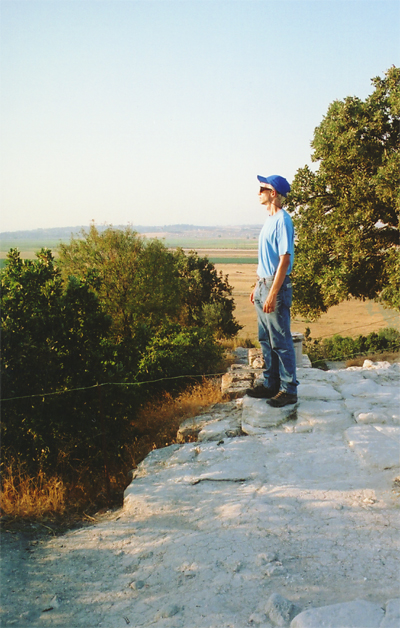
Eric Shanower gazes across the plain from Troy.
The first time I encountered Ibrahim at Troy was on an evening I sat in the ruins until after closing. Ibrahim's job is to watch the tourist entrance to Troy and to do a sweep of the site after closing to make sure all the tourists are gone. I'm not sure what his job title is, something like "gatekeeper," I guess. That evening Ibrahim came by and told me it was time to leave.
The next day I went to the site an hour or so before closing, approaching Troy through the field north of the entrance drive, an area I've drawn several times in Age of Bronze, most recently in issue #23 when Priam is taking the royal family out to the countryside for one final picnic.

Priam leads his wives, children, and grandchildren through the fields east of Troy.
As I reached the site, Ibrahim spotted me and asked to see my ticket. I told him I didn't have one, but that I'd go get one for the short time the site would remain open that day if he insisted. He just wanted to see my ticket, he told me, as he escorted me toward the exit. He asked whether I was the one he'd told to leave the day before. I answered, "evet"--Turkish for "yes." I tried to explain that I'd been there for several days already and I'd only bought a ticket the first day. Ibrahim's English was reasonably good, but he was far from fluent. I couldn't tell whether he understood what I was trying to communicate. Anyway, he didn't make me leave or pay, so I stayed till closing.
The next morning I went to Troy for the whole day, so I bought a ticket. Who should I run into as soon as I passed through the entrance but Ibrahim. Ibrahim seemed to find it odd that I kept showing up. Most tourists spend a couple hours--at most--seeing the site, then they leave. I decided I better make friends with Ibrahim, so I introduced myself and tried to explain that I was at Troy for twelve days to gather research for my comic book about the Trojan War. This was one of the moments where it was a real problem that I had no sample issues of Age of Bronze. I took out a piece of scratch paper and quickly sketched some panel borders and filled them with rough figures and outlines of word balloons. Ibrahim said he understood, but from his expression, I'm not sure he did.
Ibrahim wasn't mean. He was actually a very nice guy just doing his job. That afternoon on the site I tried to telephone Prof. Haluk Şahin on the island of Bozcaada to let him know I'd be arriving there Friday for The Day of the Poet and the Reading of the Iliad. I couldn't manage to work the pay phone on the Troy site, so I decided to phone from the Hisarlık Hotel instead. I asked Ibrahim whether he'd let me re-enter the site if I left for a little while. He looked doubtful and asked why I wanted to leave. When I explained my trouble with the pay phone, he helped me put my call through.
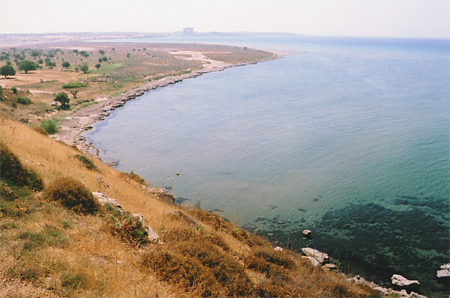
Beşik Bay, where the Achaeans may have landed to attack Troy.
The Bronze Age coast lay significantly inland of the present coast.
Notice the cement factory in the background.
The next day I hiked to Beşik Bay, where Prof. Korfmann suggests that the Achaean army camped during their war on Troy--if the war actually happened. I also tramped through the Keşik Canal, a strange gully-like corridor that cuts through the Sigeum Ridge from the plain to the sea just south of Keşik Tepe. The canal doesn't look like a natural formation, but when it was made and who made it I've been unable to find out.
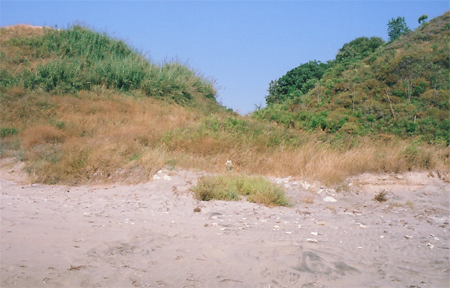
Looking east from the Aegean coast through the Keşik Canal.
When I hiked back to Troy that evening and entered through the back fence, almost immediately I ran into Ibrahim. He demanded to see my ticket. When I said I didn't have one that day, he asked whether I was leaving. I said yes, but then had an idea. I waited by the exit for him to finish his sweep of the site, then took Ibrahim with me to the excavation team area and asked one of the excavation team members to explain to Ibrahim who I was and that it was all right that I was there. At last Ibrahim got the message, I guess. He didn't try to kick me out of the site after that. When we saw each other, we'd wave and say "merhaba!"
I also made friends with the security guard at Troy, Sedat Tezcan. Sedat wore a uniform, a black cap, and carried a billy club, but his main function seemed to be to tell tourists to put out their cigarettes. This was no health consideration, but a safety one. The grass all over Turkey in late summer was dry and yellow. One spark could start a conflagration. In fact, one of the hills inside the site was black from a recent fire, most likely begun by someone's cast off cigarette.
It's probably pretty tedious walking through those ruins day after day if you're not gathering information for a comic book. Whenever Sedat saw me, he'd call me over to walk with him through the site, or sit for a while with him on the bench beneath the huge fig tree in the middle of the citadel. That bench beneath the fig tree became my second favorite spot in the area. It was a great place to rest during the heat of the day and drink some water or a can of cherry juice. I drank more and more cherry juice--vişne nektari--as the days went by. I don't know why they don't sell cans of cherry juice in the USA. It's not like one of the manufacturers isn't the Turkish branch of the Coca-cola Company!
One day Sedat led me to the northern edge of the citadel and pointed down to one of the fields in the plain below. He told me that was his father's field. He pointed out his father working down there, then called his father on his cell phone. Sedat's father had turned off his own cell phone, so Sedat didn't get through.
The day Peter Pavúk gave me his tour of Troy, he invited me to second breakfast with the excavation team. Since it's a German-led expedition the team has four meals a day: breakfast at 6 am, second breakfast at 10:30 am, lunch at 2:30 pm, and dinner at 6 pm, all prepared by four or five Turkish women. I was told that since the number of team members was smaller this year than it used to be, more money could be allotted toward food, so the meals were better than in the past. They weren't fancy, but I found them satisfying. I was so excited to be eating with the members of Project Troia, that I didn't care much what the food was actually like. Everyone sat together at a couple long tables inside a pre-fab building and took portions from platters or bowls. Boarding house reaches weren't frowned upon. Conversation was sporadic. After meals we had to clear our own places and separate dishes from silverware into pans at the front of the room. Then everyone went outside with coffee, tea, or water to relax for a few minutes before returning to work.
Peter also let me check e-mail on his computer, the only chance I had to do that during my entire time in Turkey. The keyboard was Slovakian, so in the messages I wrote I apologized for any anomalies--I never did locate the apostrophe key--but you can bet I boasted to those I wrote to that I was e-mailing from the dig house at Troy.
Wendy Rigter of Tübingen University showed me the study collection of pottery at Troy. She apologized that all the spectacular pieces they'd found are in the Archaeological Museum in Çanakkale. But I didn't mind one bit. An expert's one-on-one explanation in the dig house at Troy about, for instance, the difference in bowl lips between Troy VI and Troy VII pottery, while handling the pieces, needs no apology.
The morning of my trip to Tenedos (Bozcaada), I packed a change of clothes, since I'd be staying on the island overnight, and caught the dolmuş to the highway where I hopped a bus to Geyikli. When the bus reached Geyikli, it passed the turn to the ferry dock and proceeded into town. It seemed as if the bus wasn't going to take me directly to the ferry, so I got off. I started back through Geyikli toward the ferry dock, only to see the bus I'd been riding pass me in the direction of the ferry dock. I'd gotten off the bus too soon!
The ferry for Bozcaada would be leaving at 11 am--half an hour. If I missed it, I'd have to wait around for three hours until the next ferry. I quickened my pace. As I trotted along the road, I could see beyond the trees the ferry from Bozcaada approaching the dock. Judging by its distance, I realized I couldn't reach it before it departed back to the island. I started an easy jog, but no jog in the Turkish midday summer sun in hiking boots, with two camera cases and a daypack is easy for long. A dolmuş passed me toward the dock. If only I'd had the presence of mind to wave it down! Maybe another one would come. I kept walking, looking back each time I heard an approaching engine. Finally another dolmuş came by. I flagged it down and rode to the ferry dock in time to catch the 11 am ferry.
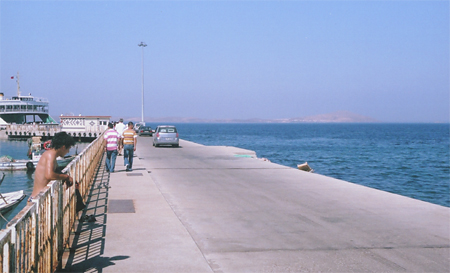
The ferry landing near Geyikli.
The ferry's destination, Bozcaada (Tenedos), sits on the horizon.
When I got off on the island, I tried at several pay phones to call Haluk Şahin, but no luck. None would accept my credit card. At last I went into a money exchange office where I could make a phone call for cash and arranged to meet Haluk at Ada Cafe.
Earlier I'd bought The Bozcaada Book by Haluk Şahin, the English version translated by his daughter Ayşe, and was perusing it in front of the cafe when both of them walked up and greeted me. They drove me to the hotel where there was a room reserved. Ernst Pernicka, director of Project Troia, had originally planned to come to Bozcaada, too, but had to cancel, so I took over what would have been Ernst's hotel room. Rüstem Aslan also planned to attend the events and would be arriving later.
The resort hotel, Ataol Çiftliği, with well-tended grounds and sparklingly clean rooms, sits on a hillside overlooking the Aegean. The main lounge has a charming touch: swallows have built a nest in the rafters and swoop around near the ceiling and through the doorways. The price to stay at Ataol Çiftliği happens to match its amenities and charm, but I didn't mind paying for a single night--my one mosquito-free night in Turkey. Such luxury!
Here's the info for those interested:
Ataol Çiftliği Hotel and Restaurant
Tekirbahçe Mevkii
Bozcaada/Çanakkale
Telephone: 0286 697 03 84
Fax: 0286 697 83 29
Website: www.ataolciftligi.com
After taking a few moments to settle into the room I walked up the hill behind the hotel to see what there was to see.
In the as-yet-unfinished Age of Bronze #24 I've included a scene of the Achaean army drilling for battle on the island of Tenedos. The men charge up a hill. At the top Great Ajax stops them. A moment later Ajax descends from his chariot on one side of the summit to see another group of men walking from the adjacent hills toward the shore.
As I stood on the top of the hill behind the hotel, I gradually I realized that I was in the very location of that scene--a scene that I'd just drawn a few weeks previously, constructed from a few reference photos of unspecified locations on Tenedos and my imagination. The real vegetation was a little different, and there were more rocks than in my drawings. But such minor alterations would be no trouble. The hills in the distance would need a little tweaking, too, but the rest seemed identical.

The view from the hill behind Ataol Çiftliği on Tenedos.
I asked the hotel manager, Yakon, if there was a car that could drive me around to see the island. The one he came up with had a broken parking brake. Once for a year or so I drove a car without a parking brake, simply parking in gear on hills. So at first I thought Yakon's car would suffice, but when I recalled the road conditions around Troy and realized that I'd never driven in Turkey and never driven this particular car, I decided that driving probably wasn't the best idea. Yakon suggested a motorbike. I was doubtful, since I've never even driven one in the USA. A bicycle? That was the answer!
So I rented a bike for three hours and rode all around the island. I wanted to take my cameras and daypack with me, but the only bicycle with saddlebags at the rental place was the owner's own. He let me rent it. He packed my stuff into the saddlebags, showing me how to undo the ties. Every time I wanted to take a picture, I had to undo the ties while standing up with the bike so that it wouldn't fall over, take a camera case out of the saddlebag, take the camera out of its case, take the picture, then reverse the process before I could be on my way again. It gave me a chance to rest while bicycling, but it was a bit of a pain. After a couple times of digging out the still camera, I decided to use only the camcorder. And after a few times setting up the tripod, I switched to handheld taping.
The rental guy gave me gloves, a helmet, and a map on which he showed me the flattest routes around the island. He was obviously a little concerned about his bike, making sure I knew it was worth a thousand lira. The last thing he told me was that the roads were Turkish roads, not roads in America or Europe, so I needed to be careful.
Well, I was careful. No crashes. But at the end of three hours I was drenched in sweat. In hiking boots and long pants, I wasn't dressed for bike-riding in that heat. Many of the roads were flat or downhill, but there were some stretches where it was significantly uphill. Even in the lowest gear, I couldn't make it up the hill from one beach. I had to walk the bike up to a stretch less steep. I sweated so much that the map of Bozcaada in a back pocket became so wet that the action of my pedalling caused enough wear to make the map indecipherable in spots. At one point I was afraid I'd get lost because I wouldn't be able to read the map anymore.
Nonetheless, the ride was exhilarating. Bozcaada is a small island and I covered most of it. I stayed away from the southeast point where, according to the bike rental guy, most of the hills were. First I took the road through vineyards along the central ridge to get an overview. Then I headed for the western end, which, I knew--from both my research and from little green triangles on the map--was wooded. I wanted to see how closely reality matched what I'd already drawn in Age of Bronze.
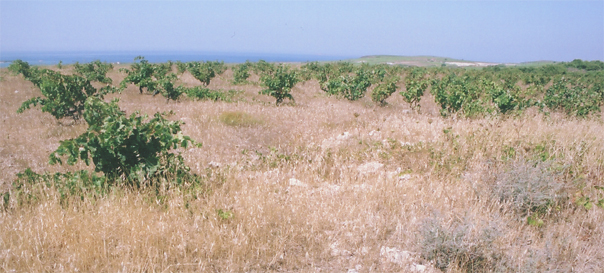
The famous vineyards of Bozcaada (Tenedos).
In issue #21, several characters enter a wooded area of Tenedos in search of an altar. They find it in a clearing--a pretty good-sized clearing, since the leaders of the Achaean army hold first a sacrifice then a big feast. Imagine my gratification as, cycling along the road through a pine forest, I reached to a good-sized clearing in the trees, large enough to hold a sacrifice and feast. And it even sloped gently westward as I'd drawn! True, I should have drawn more pine trees and fewer deciduous ones, but I was amazed by how close I'd come to reality before seeing it.
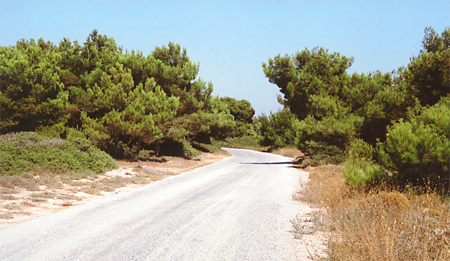
A pine forest on the western end of Bozcaada (Tenedos).
Was this where the two Ajaxes stumbled over Thersites in Age of Bronze #22?

In Age of Bronze #21, Palamedes leads the Achaeans in sacrifice
in a forest clearing on Tenedos.
In Age of Bronze #20 I'd drawn the Achaean army sailing along the south side of Tenedos, then swarming up cliffs and hills that rise from the sea. I wondered whether my drawings of cliffs and hills could possibly find real life counterparts. It seemed in doubt since my map of Bozcaada indicated that the south side of the island is lined with public beaches. I found that the map was right. But I'd been right, too. Surrounding the beaches were cliffs and hills rising from the sea, just like I'd drawn. And when I looked out to sea, there was a line of ships moving slowly past the island. They were modern tankers and cargo ships, to be sure, not Late Bronze Age single-sailed vessels. But I didn't care--for a moment the Late Bronze Age and my present had become the same.
Festivities for The Day of the Poet and the Reading of the Iliad began at 6 pm with the opening of a museum, the Bozcaada Yerel Tarih Araştırma Merkezi (Tenedos Local History Research Center). After I returned the bicycle I didn't know exactly where to go, but was walking along the street of the port town when Ayşe Şahin walked up. She guided me to the right place, not exactly a museum, but a center for the display of a collection of artifacts from and about Bozcaada (Tenedos). First there was a reception in front of the building with local wine and grapes. Haluk introduced me to his wife, Belgin, and several of his friends who'd come to Bozcaada for the events of the weekend as I had. Rüstem had arrived as well. I felt greasy with sweat from my bike ride, and so I was a little uncomfortable meeting so many new people, but no one reacted as if I smelled or anything.
The mayor of Bozcaada and M. Hakan Gürüney, the young man who'd collected the artifacts now housed in the center, made some speeches for the news media in Turkish. Then they cut the ribbon in front of the doorway and everyone went in. I found the maps of Bozcaada (Tenedos) most interesting. They showed so many different conceptions of the island over the centuries. There were also postcards written by French soldiers stationed on the island in World War I. The collection had actually begun with sea shells, so these were widely represented. Downstairs were histories--along with furniture and clothing--of long-time residents of the island.
I was, as usual, carrying my cameras and daypack and was beginning to get a bit weary, so I was glad when we moved to a tavern for drinks. I was a little uncomfortable at first since I knew almost nobody, and those I did know I'd only recently met. But everyone was friendly. At one table people were mostly speaking English so I drifted toward it and they invited me to sit down. Among them was a television production team from Los Angeles run by Sarah Wetherbee, Haluk's daughter-in-law. They were busy working on a show for the History Channel, a series about cities with underground levels. They were open to suggestions for cities to visit for the show. I could only think of Seattle, whose underground streets I toured in the 1970s, but they already had Seattle on the list.
Sarah and her team of three--two young women and one of the most drop-dead gorgeous young men I've ever met--had been at one of Bozcaada's beaches that afternoon. There they'd seen a group of snakes swimming through the water. Fish jumped out of the snakes' path. So did swimmers. As soon as I heard about this I needed to know the details. What were these snakes? How big were they? No one there had ever seen anything like it before. Ayşe thought they might have been eels, but the production team insisted they were snakes. I quizzed them for all the information I could, but those snakes are still a mystery. I'll find an answer, though. Anyone who knows the Laocoon episode of the Trojan War will easily guess why I need to know all about water snakes from the island of Tenedos.
On the table at the tavern sat a little bust of Homer. When I mentioned it, the others told me that anyone who planned to participate in the reading the next day at sunrise was supposed to kiss the bust of Homer and rub it on his or her forehead for luck. I don't believe in luck, but I have no problem with ritual, so I performed as instructed.
Eventually everyone proceeded to a jetty where chairs had been set up facing a microphone. There were over a hundred people now, I'd guess, and each of us was handed a complimentary glass of wine. Haluk welcomed us all to the event in Turkish. His daughter Ayşe translated into English.

Prof. Haluk Şahin welcomes everyone to the opening evening of
The Day of the Poet and the Reading of the Iliad.
Ayşe Şahin translates her father's remarks into English.
The bust of Homer on the stand at left is the one
the next day's readers were to kiss and rub on their foreheads.
Haluk's remarks included recognition of special guests, and to my delight I was included among these. Each year a local Turkish poet reads his work aloud as the main event of the evening. Haluk introduced this year's poet, who read in Turkish, of course, so I didn't understand his poetry. But sitting there on the jetty, drinking my Bozcaada wine and relaxing from a day full of friendly people and welcome experiences, I could look across the little bay to the impressive sight of Bozcaada's fortress, an imposing structure Venetian in origin but greatly expanded by Mehmet the Conqueror. Behind us, a huge rock blocked the sunset, but as I watched, the sky faded from Maxfield Parrish blue to a darker blue, rich, velvety, and lightly sprinkled with stars.
Afterward Haluk's guests and friends gathered at the Mitos Restaurant on the waterfront. We sat at tables arranged in a large rectangle and chatted while waiters continued to pour wine and serve food. I don't even remember what I ate. I just ate whatever appeared on my plate. It was all delicious.

The Venetian fortress on Bozcaada (Tenedos) was visible all through dinner.
One thing Haluk had said several times that day was that Troy still burns every night. At dinner he explained to me what he meant, that there's still war in our world, unnecessary conflicts brought about by human failing. Those aren't the exact words he used, but I think that's the gist. Haluk, I apologize if I've misrepresented your meaning.
In concurring with Haluk, I volunteered the information--though I usually prefer not to discuss my themes in Age of Bronze--that this exact idea was one of the reasons for my retelling of the Trojan War story. I pointed out that the Trojan War was merely the earliest example of the oft-recurring conflict between east and west. I guess I could've mentioned the Persian Wars or Alexander the Great's campaigns or the Crusades, but instead I brought up the events begun on Sept. 11, 2001, as an instance of that conflict. I thought that was a resonant example of unnecessary conflict brought about by human failing.
Tony Marciniec, an ex-patriate American from Bodrum, writer and editor for BodrumLIFE, took exception to my statements. He adamantly defended the Turkish people against any idea that they wished harm to the USA. I'd had no intention of even alluding to such an idea. I never thought it before I went to Turkey; I certainly didn't think it while I was in Turkey, much less while being treated so generously by its citizens. Had I touched a nerve without realizing it had even been there?
I probably should have dropped the subject right away, but I'd had a few glasses of wine, and I believe there are valid parallels between events set in motion that day five years ago and events of the Trojan War. So instead, I tried to justify my points to Tony. But whatever I said, he seemed to disagree with. That conversation petered out uncomfortably. Afterward, I was relieved to find Tony as cordial as before.
Haluk's brother drove Rüstem and me to the hotel for a few hours sleep, and later, just before sunrise, drove us to the beach facing Beşik Bay and, beyond the bay, Troy. There, people had assembled for the reading of Homer's Iliad. In previous years they'd gotten through Book 19. Six books to go, including some of the best parts: Hektor's death, the funeral of Patroklus, and Priam's encounter with Achilles.
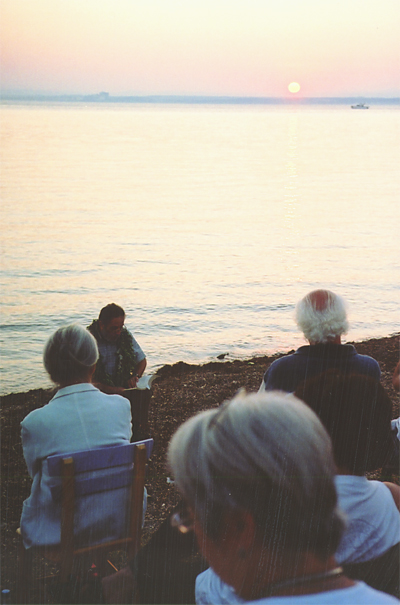
Reading Homer's Iliad aloud on the beach
on Bozcaada (Tenedos) as the sun rises.
The colors of the world around us were muted, but soon the intense orange edge of the rising sun penetrated the gray haze on the horizon. First to read was the poet of the previous night. He read aloud in Turkish, as did most of the readers. Others read in German or English. I followed along well enough in my Lang, Leaf, and Meyers translation as Achilles slaughtered Trojans in the Skamander river, and the river rose up in fury to fight the son of Peleus. Haluk brought in each new reader at a logical break in the poem. Book 20 took about an hour. We began Book 21 in which the gods join in the fight. Haluk called on me to read so I made my way to the water's edge and donned the neck-wreath of leaves that all the readers wore in turn. There was a chair, and most of the readers had sat, but I was too excited, so I stood and read aloud the scene of Hera battering Artemis with the archer goddess's own bow and Leto gathering the scattered arrows.
When Book 21 was finished, Haluk ended the reading until later that day. I was a little disappointed. I'd really been looking forward to hearing the rest of the poem, even in languages I didn't know. But I planned to return to Troy that day. So after breakfast at a nearby cafe with several of the reading attendees, Sarah was kind enough to drive me back to the hotel to check out, then drop me at the ferry.
During the ride back to the mainland I fell into conversation with a friend of Haluk's, Stephen Kinzer, former foreign correspondent for the New York Times, and author of a book about Turkey, Crescent and Star. Stephen had also read a portion of Homer's Iliad at the beach that morning. In discussing Troy and the Trojan War, one thing I said to him remained with me strongly: that I can never reach the Land of Oz, but that I can travel to Troy. And it's true. The two major areas of creative work in my professional career, Oz and Age of Bronze, are based on works by others, works that have elaborate geographical underpinnings. In the case of L. Frank Baum's Oz, the geography is pure fantasy. But in the case of Homer's Iliad, although the action of the story is remote in time, the land is still there. Many geographical features remain. Even ruins of the structures, evidence of the culture of the characters, are still there for anyone to go see. I can never reach the Land of Oz, but I can travel--I have traveled--to Troy.
Part Four
Copyright © 2006 Eric Shanower. All rights reserved.
|
|
|
Home |
Issues |
Books |
T-shirts |
Blog |
Pronunciations |
Our Story So Far
Free Features |
Store |
Privacy |
Links |
Archives
Eric Shanower |
Hungry Tiger Press
All materials are Copyright © 2000, 2001, 2002, 2003, 2004, 2005, 2006, 2007, 2008, 2009, 2010, 2011, 2012, 2013, 2014, 2015, 2016, 2017, 2018, 2019, 2020, 2021, 2022, 2023 Eric Shanower. All rights reserved.
The Age of Bronze logo and all prominent characters and their likenesses are trademarks of Eric Shanower.
Image "i" logo is TM and copyright © 1992-2023 Image Comics, Inc.
No portion of this website may be used by generative artificial intelligence without written permission.
Website designed by Digital Sourcery
Contact Webmaster
Contact Eric Shanower
|

|
|
|

